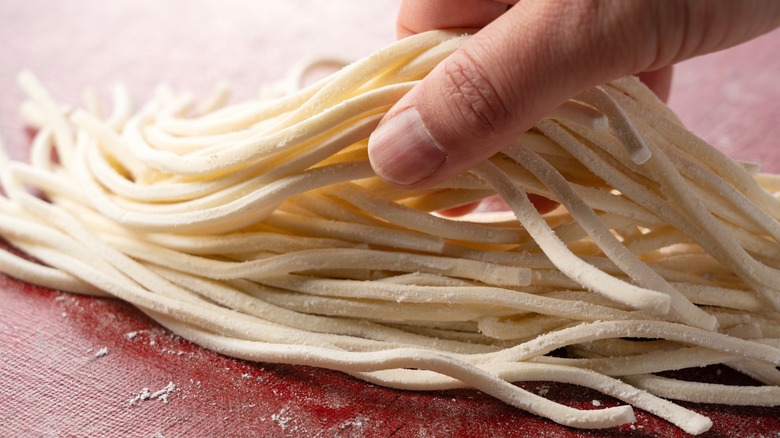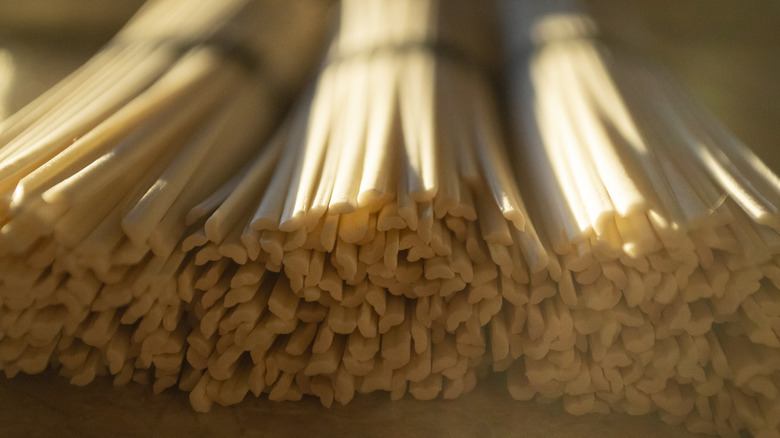The Major Differences Between Dry And Fresh Udon Noodles
Soba and ramen may receive most of the Japanese noodle spotlight, but there's also another equally tasty noodle in the mix — udon. The thickest variety enjoyed in the East Asian nation, udon noodles are characterized by their distinct chewiness. The texture lends the perfect bite to soups, chilled dishes, and stir-fry.
To optimize the most of udon, it's necessary to consider how it's stored. Udon is found in fresh, frozen, and dried varieties. When purchased from a store with consideration for spoilage — typically vacuum packed — it means the noodle's pre-cooked. Such fresh variants have a much thicker mouthfeel than their dried counterpart and will remain sturdy throughout preparation.
Dried udon presents a texture more similar to pasta and is prone to turning mushy. This type contains less of the characteristic chew, but it's still a delicious dried noodle. With some careful prep, it'll still add a delightful element to a broad range of dishes. Let's dive into the specifics of each type of udon are prepared.
How to cook with fresh udon
Fresh udon noodles come together with only a handful of ingredients: flour, salt, water, and starch for dusting. The process starts with an initial mixing of the components, which is formed into a firm ball. After the dough's rested for around 30 minutes, the most labor-intensive process initiates: the kneading. Since its texture is exceptionally tough, it's traditionally placed into a closed bag and stepped on until it's flattened. The process is repeated several times until the dough achieves a malleable texture. It's then allowed to rest for several more hours before being rolled out and sliced into individual noodles. To finish, the fresh udon requires around 10 minutes to boil.
Rather than being assembled from scratch, fresh udon is often pre-cooked and sealed in vacuum packages for sale. In this state, the noodles need to be refrigerated or frozen after purchase, because they're not as stable as dried udon. However, the noodles only require two to three minutes to cook.
Udon noodles are especially chewy when fresh. Their durable texture makes them less likely to disintegrate during cooking, making them better suited for soups — such as the classic soy-based kake udon. However, they can be used in other noodle dishes too, like a delicious stir fry or beloved chilled noodle dish called hiyashi yamakake. Take note that the fresher the noodle, the chewier the consistency, so adjust accordingly.
Preparations with dried udon
Dried udon noodles are produced in a thinner shape; they're flat and long, like a linguine. While their dough makeup is similar, the noodle dehydrating process lends them a different texture. Noodle drying utilizes environments with regulated humidity and airflow; so much of the chewy consistency is sacrificed for shelf-life. The dried udon is also less durable, with a soft mouthfeel that's prone to falling apart.
As a result, the noodles are worse for applications with intense heat. For example, when stir-fried in a wok, the starch will likely clump onto the pan rather than mix with the sauce. Rinsing the udon after cooking helps remedy the issue. Another method maintains the noodle's texture by continuously adding cold water during the boiling process. The dried variety of udon typically requires five to seven minutes to cook, so keep a close eye to not overcook.
With a more delicate texture, dried udon functions well in cold noodle dishes. Chilling the noodles after cooking aids in preventing a mushy texture. Or substitute the noodles into a recipe where they're tossed with a sauce, like a Mentaiko udon bowl. While it won't have the same chewiness, dried udon can still be added to soups, too — like the dashi-flavored kitsune udon. The dried variant is still malleable; it simply needs extra careful preparation.


